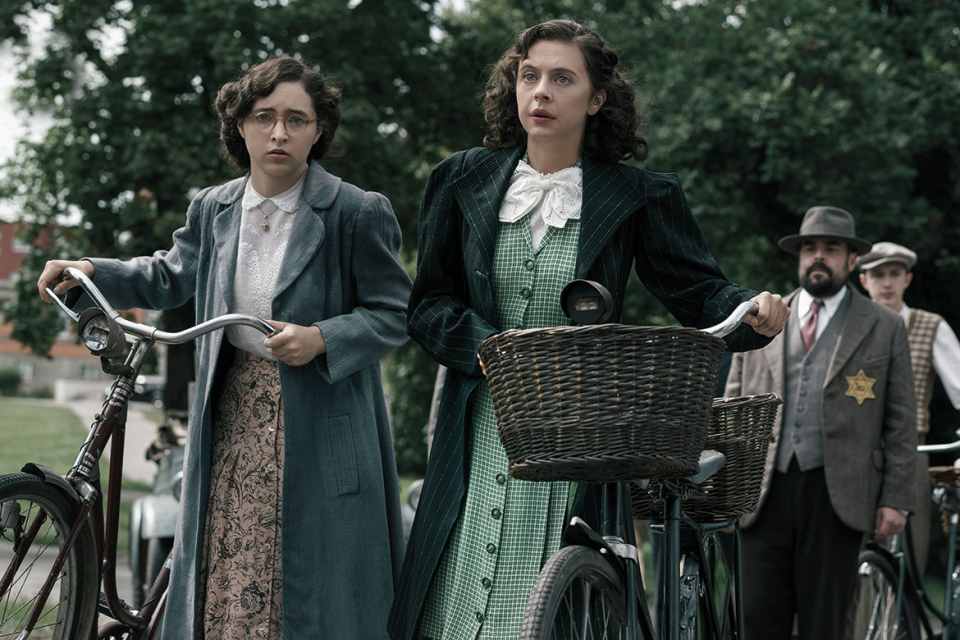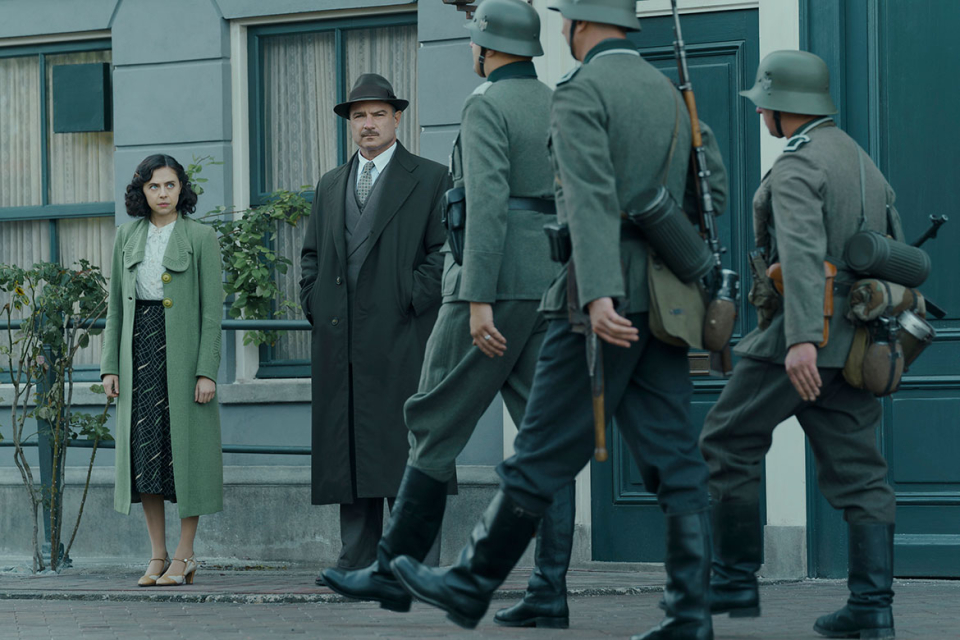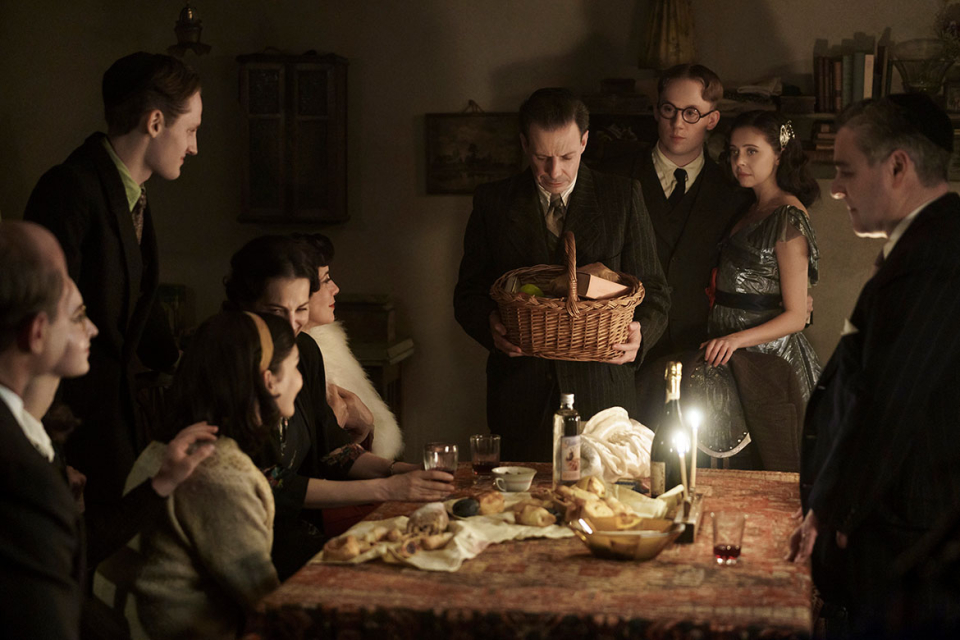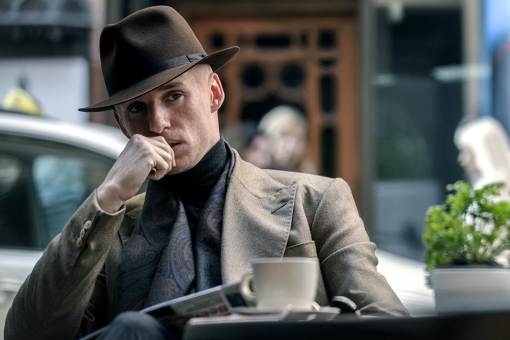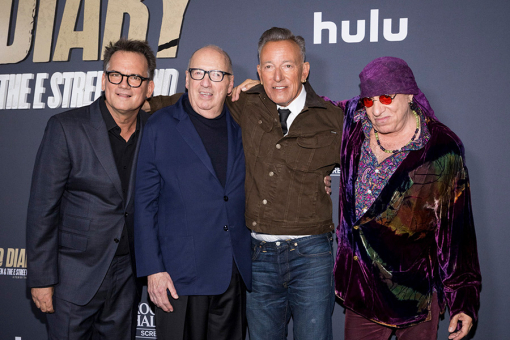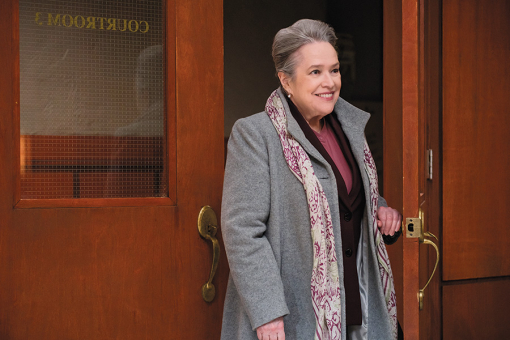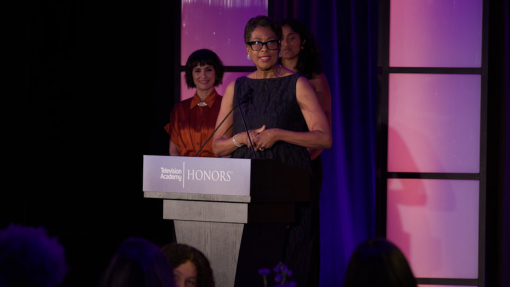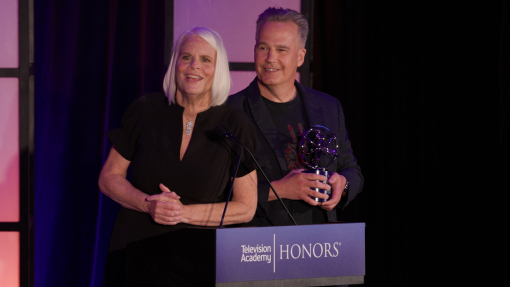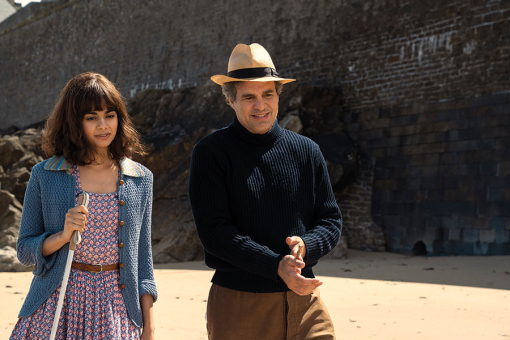It's a gloomy day in Prague until flashes of orange pierce the gray.
Three hundred extras wave flags of the Dutch royal colors as they rejoice on cobblestone streets that stand in for Amsterdam.
On May 5, 1945, the day being recreated for A Small Light, those joyful sounds celebrating liberation from the Nazis would have wafted up to the small attic where Anne Frank once hid. Yet by that day, the attic of the secret annex was empty.
Anne had already died of typhus in the Bergen-Belsen concentration camp. She was fifteen.
This limited series, though, is not another retelling of the young writer's story. A Small Light focuses instead on the woman who opposed the Nazis, risking death to sneak food and supplies to eight people in hiding — for more than two years.
Were it not for Miep Gies (pronounced Meep Geese), no one would know the name Anne Frank. After the Nazis arrested the Franks and the four others in hiding, Gies sneaked back into the secret annex and collected Anne's red plaid diary and other papers. She saved them — never reading a word — hoping to return them to her.
Instead, after the war, she gave them to the family's lone survivor, Anne's dad, Otto, who then published The Diary of a Young Girl. Translated into seventy languages, it has sold more than thirty million copies.
Today, when there are still large numbers of people who deny or are ignorant about the Holocaust, Gies is largely forgotten. She never sought accolades and downplayed her heroism. "Miep said she was just doing what anyone would do," says Joan Rater, who, with husband Tony Phelan, created, wrote, executive-produced and served as showrunner on A Small Light. "And she meant it. We know that not everyone would — because not everyone did — but she did it without thinking. Why? That was sort of our historical question. Who is this person who makes that snap decision?"
Over eight episodes, premiering May 1 on National Geographic and streaming on Disney+ the following day, A Small Light tells us. Bel Powley (The Morning Show) portrays Gies as a pragmatic, spirited young woman who, enraged by Nazi brutality, is determined to do whatever she can to help.
"I didn't know anything about her," Powley acknowledges. "I, of course, knew about the story of Anne Frank. I know a lot about the Holocaust in general, but I actually knew very little about the Dutch Resistance. My partner's grandmother is Dutch, and they hid Jews under their floorboards. She was under ten. But that's all I knew about it."
Powley and director Susanna Fogel (The Flight Attendant) are Jewish, as are much of the cast — Billie Boullet (The Worst Witch) as Anne, Ashley Brooke (The Blacklist) as sister Margot and Liev Schreiber (Ray Donovan) as Otto. Holocaust horror stories were always part of their lives, yet none knew about Gies.
Like the Franks, she was an immigrant to the Netherlands. Gies's destitute mom made use of a relief project for Austrian children and sent the sickly, starving girl from Austria to Holland, where a family took her in. When she became a fun-loving adult, her guardians pushed her to marry. Gies decided to get a job, but lacking skills, her options were limited.
Her path crossed with the Franks' when Otto's company, Opekta, needed more staff. Gies blew her job interview, but he hired her after she blurted out how desperately she needed the job. A loyalty was forged. Later, out of his own options, Otto reluctantly asked Gies for the near-impossible — to sustain his family. She didn't even stop to think. Only a few other office workers and Gies's husband, Jan, were in on the secret.
"I don't think many people realize that the person taking all the risks in this situation is this young woman, Miep Gies, one of his employees, who's not even Jewish but didn't hesitate when he asked her if she could help. She kind of organized and ran the whole show and never really got any credit for it," Schreiber says. "It's an extraordinary act of bravery and kindness and compassion."
A proud German veteran of World War I, Otto Frank was Jewish, though not religious. Keenly aware of Hitler's rise, he moved the family from Frankfurt to Amsterdam when Anne was four. As conditions grew increasingly dangerous for Jews, he tried to emigrate to America but couldn't. The day his older daughter, Margot, was to report to a labor camp, the family went into hiding.
The opening scenes depict these fraught moments. Margot does not have the papers to pass a Nazi checkpoint; she could be arrested or worse. A sweet, bookish, sixteen-year-old, she panics. Quick-thinking Gies leads her safely past the Nazis and to Opekta, where she'll climb the stairs to the attic and spend the next twenty-five months. Gies continues to be a paragon of clear thinking.
No one pays this petite woman much mind. In one scene, as she's lugging bags heavy with provisions, Nazis on a motorcycle with a sidecar knock into her, sending her akimbo. She hurls an apple at them and screams. They stop and one cocks his pistol. They take a good look at this infuriated female, laugh and drive away. She's too insignificant to shoot.
"In a weird way, her superpower was that she was constantly underestimated," Phelan says. "She's a very small, very unobtrusive person. And I think that's why she wasn't arrested by the Nazis — because she was a little secretary."
Gies's most famous quote, which the title references, explains her philosophy. "I don't like being called a hero, because no one should ever think you have to be special to help others. Even an ordinary secretary or a housewife or a teenager can turn on a small light in a dark room."
Before production began in Amsterdam, where some scenes were shot, Powley biked the same paths as Gies. Since the Anne Frank House is a museum, production couldn't shoot there. Instead, it built a replica in Prague that was so realistic that the actors, who were already empathizing with their characters, were deeply affected.
"Obviously, I can't even begin to imagine what it was actually like to be in there," Powley says. "But you get that sense of the claustrophobia and dealing with really heavy issues. I think it's been important for us as actors, as people, to spend time together — not just Miep and Jan talking but having these intense situations."
As Jews were rounded up, that intensity mounted for those hiding in the building at Prinsengracht 263. Crammed into the attic were the Franks (Anne, Margot, Otto and mom Edith), the Van Pels family (Otto's business partner, Hermann, plus wife Auguste and son Peter) and family friend Fritz Pfeffer, who arrived later.
The startling accuracy of the set extended to postcards tacked to the walls. This detail resonated with Amira Casar (Call Me by Your Name), who plays Edith. She'd visited the annex over the years with her own mother, who "always spoke to me about Anne Frank as a very unique young writer who'd been sacrificed by the Nazis and that this should never happen again," Casar says.
Working in Prague was a visceral experience for Brooke, whose grandmother, Esther Katz, was a survivor. Arrested in Czechoslovakia, Katz was sent to Auschwitz and Bergen-Belsen. She lived to be ninety-six but died before her granddaughter landed this role.
"She was never pessimistic about anything, which I found so interesting," Brooke says. "She really described the fear that they lived in, which kind of inspired the performance that I give in the show. Her story was so impactful to me."
Margot was the obedient older sister to Anne, a rebellious teen. "This series shows the arguments, the pettiness, the laughter, the tension behind it," Boullet says. "It's a family; they're obviously going to have every single normal thing that a family would have. Just because they're famous for something doesn't mean that they're not a normal family, and I want people to take that away."
Although the series chronicles the world of eighty years ago, it feels contemporary, Schreiber says. Skyrocketing global antisemitism and a brutal war in Europe ring a bit too current for the actor, who cofounded a humanitarian group that vets NGOs in Ukraine. There, he's met others like Gies, ordinary people doing extraordinary acts.
"She didn't have to do what she did," says Fogel, who directed the first three episodes. "But she chose to do it. And that's what made her heroic, although, by her definition, she wasn't heroic. She was just a person who was doing what she believed anyone would do. So clearly, that's a very optimistic view of humanity."
Fogel considers how the fiercely resourceful Gies could be seen as an unlikely hero. "When we see and hear narratives about heroes, they're usually pretty self-serious people who do important things, humorless martyrs," Fogel adds. "But in truth, I think the banality of her life, the relatability of her life, gives people an entry point to see ways that they can participate in their own world today or appreciate what she did, because she really didn't have to do it."
In the attic, silence was compulsory during the day. The teens studied, Anne wrote and everyone read books Gies smuggled in. They ate whatever Gies could secure and yearned for news of the outside. Outside, Miep and Jan harbored other Jews during the war. He was a social worker for the government and in the Dutch Resistance. Like his wife, Jan was self-contained and courageous.
Joe Cole (Peaky Blinders) reflects on his character, who's also largely lost to history. "I think it's incredibly important that it's revisited and retold and people are reminded of the horrors and the atrocities that were committed as well as some of the incredible acts of kindness and heroism that also happened amongst them," he says.
Their lives were marked by sacrifice, strategizing and secrets. During the war, there is little relief, but in one episode, they slip away to a swanky party thrown by Miep's friend. Jan makes them leave when he realizes the host and his friends are Nazis.
The party gives Miep a rare chance for glamour. She stops at the attic on her way out and Edith insists on loaning her an elegant blue organza dress. Mrs. Van Pels reluctantly offers a cherished swan-down cape. The women had brought with them their favorite belongings, finery that would never be worn again.
No one knew what to take into hiding. As costume designer Matthew Simonelli notes, Anne brought her ski boots. Simonelli rented Nazi uniforms from costume shops and dressed the cast in fashions from the 1930s and '40s. The women waving the orange flags wore thick seamed stockings and the men's hats had seen better days.
Everything in the annex also needed to take on the sheen of overuse, given the twenty-five months the families spent jammed into 500 square feet. Production designer Marc Homes pored over historical photos stacked around his set office.
He oversaw the creation of 150 sets, including a dead ringer for Café 't Mandje, a gay bar where the Resistance met. Even though the set is new, it feels dusty and old, with yellowing Dutch newspapers stacked in the back office and velvet-flocked wallpaper in the public area. In setting the visual tone, Homes deliberately used Nazi symbols sparingly, so they retain shock value.
"That red burns through everything," Homes says. "The orange was to show liberation and the red to show fear."
The power of hate symbols hits hard in a scene toward the end. The Nazis have arrested everyone in the secret annex, yet Gies can't give up. She decides to bribe officers to gain her friends' freedom. It sounds crazy, but no crazier than all she's done. As this small woman clutches a satchel with cash, she's framed by bright red banners with white circles and black swastikas streaming from a government building. It's a public stance of bravery — one citizen against an evil empire.
The series reveals private moments that do the same — kindness at markets where vendors slip Gies extra provisions. And it reminds us that Anne was a typical girl. Willful teenage girls challenge their moms — even if they'rein hiding for their lives.
"We wanted to strip away the kind of sepia, reverential" way people approach the Anne Frank story, says Tony Phelan, who directed the final three episodes.
Initially, he and Rater became intrigued by Gies when they saw a 1995 documentary about her. They later took their children to the Anne Frank House, where he says the guide told them, "You have no idea how many young people come to this place with no idea who Anne is, because they don't teach it in schools the way they used to."
The couple, whose credits include Grey's Anatomy and Fire Country, began six years of research into this little-known woman who lived to be 100.
"She was so adamant that she never wanted to be called a hero," Phelan says, referring to the famous quote that gives the show its title, adding, "It is just a matter of these little individual decisions that you make in life. Don't put me up on a pedestal. Don't put Anne up on a pedestal. That's not what this is about. This is about saying that anybody can do it. You have it within yourself to make the right decisions."
Executive producers on A Small Light are Joan Rater, Tony Phelan, Susanna Fogel, William Harper, Peter Traugott, Avi Nir, Alon Shtruzman and Lisa Roos, with David Minkowski and Matthew Stillman as coexecutive producers. The program was produced by ABC Signature and Keshet Studios for National Geographic.
This article originally appeared in emmy magazine issue #3, 2023, under the title, "Angel of Amsterdam."

